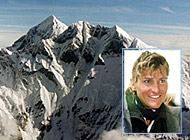Binsack confronts Everest and her critics

Evelyn Binsack, the first Swiss woman to climb Everest, has returned to tackle the world’s highest mountain without using oxygen – and set the record straight.
When the mountaineer scaled the 8,848-metre-high peak in 2001, some climbers belittled the feat because she used supplementary oxygen on her way to the top.
In an interview in the Nepalese capital Kathmandu ahead of the climb, Binsack told swissinfo that the criticism still rankles her.
She says she is back to prove something to herself and her critics.
swissinfo: Why have you come back to climb Mount Everest?
Evelyn Binsack: The answer is actually pretty easy. I was invited to join a team for free and as climbing Mount Everest is normally very expensive I had to go.
swissinfo: This time you are planning to climb it without the use of oxygen. Why is this so important for you?
E.B.: I want to find out whether I can do it. When I came here in 2001 I did not even consider not using it as I did not want to ruin my chances of becoming the first Swiss woman to climb Mount Everest. And let’s face it, the first Swiss man (Juerg Marmet in 1956) used oxygen as well.
swissinfo: Are you trying to prove something to yourself or to the male climbing fraternity by not using oxygen?
E.B.: Having been up Everest before, I need a new challenge and climbing it without oxygen has become my new challenge. Four years ago I was heavily criticised for having climbed with oxygen. My fellow Swiss climbers said a pure Alpinist should not have used it. So I have two reasons: one is to see whether I can do it and the other one is to show my fellow Alpinists that I can do it.
I am not planning to climb all 14 of the 8,000-metre peaks on this planet. I want to do something new, something that maybe involves less risk. So if I manage to climb Mount Everest without oxygen, it would be a nice way for me to say goodbye to big mountaineering expeditions.
swissinfo: You have worked as a mountain guide for more than 12 years and you are currently working as a helicopter pilot in Spain. What is it like being a woman in a man’s world?
E.B.: Sometimes it is not easy. If a guy climbs Mount Everest, for example, people don’t really talk about it. But if a woman gets up, it is still considered a major achievement. I don’t think male climbers like this very much. Men still find it difficult to share their world with women.
swissinfo: After you climbed Everest in 2001 did your life change in any way?
E.B.: Yes, it did. All of a sudden the media were interested in me and I was invited to seminars to give talks, which was a completely new world to me. Putting my experiences into words has also been a new challenge for me as I did many things out of intuition and on the spur of the moment. However, it has been good to encourage people to live their emotions and realise their dreams.
swissinfo: Was climbing Mount Everest one of your big dreams?
E.B.: When I was a teenager I thought about it, but of course I never thought that I could actually do it, or in fact finance it. But I was lucky and times have changed.
swissinfo: You achieved your feat in 2001 but what is it like this time? Are your expectations higher than four years ago?
E.B.: Everest is always difficult as it takes about 70 days to climb that one mountain. If I spend 70 days in the Swiss Alps and do nothing but climb, I can scale 140 peaks in the same period of time. So it takes a lot of effort to climb Everest and if you don’t succeed it is a big disappointment. But life has taught me that I can handle failure and this has actually made me stronger. My world will not fall apart if I don’t make it, but I will definitely need a thick skin and have to brace myself for lots of criticism when I get back to Switzerland.
swissinfo: What is you next project likely to be?
E.B.: I am planning to go to Antarctica. I want to cycle from Innertkirchen in Switzerland to Punta Arenas in southern Chile. From there I will take a plane to the Antarctic continent and then walk to the South Pole.
swissinfo: Many Everest summiteers have gone to Antarctica or the Arctic after climbing the world’s highest mountain. Why is this?
E.B.: I cannot speak for other people but I know the mountains very well and, even though they are all different, in a way they are all the same. Antarctica poses a new challenge for me and I am sure it will be very exciting.
swissinfo-interview: Billi Bierling in Kathmandu
Evelyn Binsack was born in Beatenberg near Interlaken in central Switzerland.
She has climbed the North face of the Eiger three times, including a winter ascent.
Binsack became the first woman to reach the top of the world on May 23, 2001.
Michèle Mérat followed Binsack’s footsteps to become the second Swiss woman to scale Mount Everest one year later.
Juerg Marmet was the first Swiss man to scale the top of the world on May 23, 1956.

In compliance with the JTI standards
More: SWI swissinfo.ch certified by the Journalism Trust Initiative











You can find an overview of ongoing debates with our journalists here . Please join us!
If you want to start a conversation about a topic raised in this article or want to report factual errors, email us at english@swissinfo.ch.